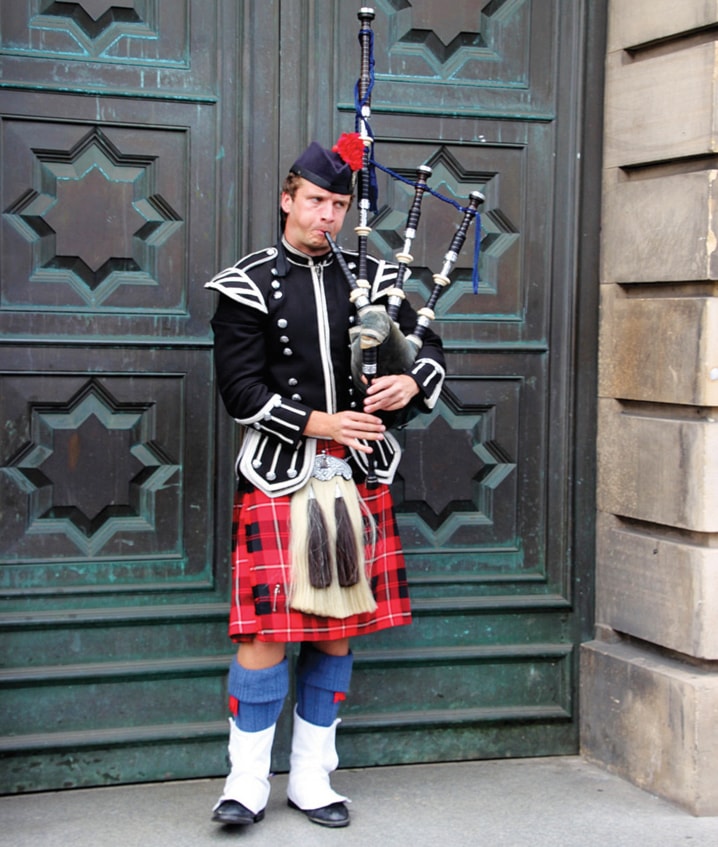All things Scottish -- from tartans to tweeds and kilts to clans — are among this fall’s favored fixations. Recently, The Wall Street Journal noted how the fashion industry is refocusing on Scottish goods, including the iconic Fair Isle sweater, as well as paisley, plaid and argyle.
The Prestonfield House may be the perfect place to stay to explore Edinburgh. Not because it was built in 1687 for the Lord Provost of Edinburgh and not because celebrities ranging from Benjamin Franklin (in 1759) to Winston Churchill, Grace Kelly and Sean Connery have all been guests.
Prestonfield is perfect because “there are lots of pretty boys in kilts,” one woman said enthusiastically.
Indeed, some of the most classically outfitted men do roam its halls. Located just out of town in a bucolic setting, Prestonfield House is home to the most famous Scottish show in the world, “Taste of Scotland.”
A dinner theater and tourist attraction, it is both corny and cool and one of the few places you can learn the history of the country in such an entertaining manner. There’s a presentation of the haggis (a dish that includes sheep heart and lungs), complete with Robert Burns’ ode to the unfairly maligned meal. It also includes tatties and neeps (mashed turnips and potatoes), Scotch whisky and the fling.
The Italians have found a way to capitalize on the craze as well. In 2008, fashion house Missoni opened Hotel Missoni in the Old Town of Edinburgh (pronounced “Edin-burr-uh”). A contemporary, design-driven five-star hotel on the Royal Mile, some of its most appealing assets are the bellboys in Missoni kilts.
The ancient Royal Mile, which runs through Old Town, is anchored by Edinburgh Castle at the high end and Holyrood Palace at the bottom, so Missoni’s presence is seen as refreshing by some, jolting by others. Either way, it’s positioned to take advantage of the throngs of tourists looking for cashmere and single-malt scotch.
Showcasing the new with the old has had its critics. In 2004, the very contemporary and controversial Scottish Parliament building was opened. It sits within a UNESCO World Heritage site across from Holyrood Palace, home of Mary, Queen of Scots, where her private secretary, David Rizzio, was murdered.
Her turbulent life ended at Fotheringhay Castle. Along with the criticism, the building has won many awards since it opened, including the Stirling Prize for excellence in architecture. The public is welcome and the main hall is often used as an exhibit space.
One recent show featured “The Letters of William Wallace,” who was executed in 1305 and made famous when Mel Gibson portrayed him in “Braveheart.”
It was with a heavy heart that Queen Elizabeth II let go of her beloved royal yacht. The Royal Yacht Britannia is now a tourist attraction berthed in the Port of Leith, just a five-minute bus ride from the center of Edinburgh. All the clocks on board are stopped at 1 minute past 3 p.m., when the queen was piped ashore from it for the last time in 1997.
Prince Charles and Princess Diana famously honeymooned on the ship. Heads of state from around the world were entertained on its decks and it was one place the queen felt was a true sanctuary. Today, it can be rented out for private parties, and tours are conducted for the public. Most rooms remain as they were, including the State Drawing Room, which the queen had a hand in decorating.
Now her favorite retreat is Balmoral Castle, in Aberdeenshire, Scotland.
Scotland’s capital city is very much defined by its history. The National Portrait Gallery offers a visual look at the past. Bagpipers provide a soundtrack to daily life both in the new and old parts of the city, and souvenir shops selling shortbread and sporrans are everywhere.
Sporrans are traditionally worn with kilts, but have great potential as evening bags. Made of sealskin, mink, leather or “hide and hair,” they range in price from about $50 to $500, depending on material and whether it is an everyday sporran or black-tie-worthy. Classic kilt pins in sterling silver or stainless steel, Scottish broaches for tartan sashes and whisky fudge and haggis chips are just some of things you can pick up in town.
Jenners department store on Princes Street is worth a visit, but for a bonanza of real-quality Scottish goods, head to the Highlands and the House of Bruar (pronounced “brewer”). It’s a sprawling shopping mecca where you will find more than you can pack (thankfully, they ship). Among the top brands are Johnstons of Elgin for cashmere coats and lambswool sweaters, Saxony and Shetland tweeds, Barbour and much more. There is even a food hall specializing in Scottish salmon, real haggis, whisky, Scotch eggs, lamb and mail-order picnic hampers. “We call it the Harrods of the Highlands,” quipped a Scotsman happy to hear the cash registers ringing.
For a country steeped in heritage, fads are as frivolous as the Scots are frugal. But you can be confident that this trend has legs that are as old as the hills.
So lace up your ghillie brogues, heat up the haggis and find your way to the land of bagpipes and Balmoral in time for Hogmanay, if not before.
PATRICIA SHERIDAN
Scripps Howard News Service
